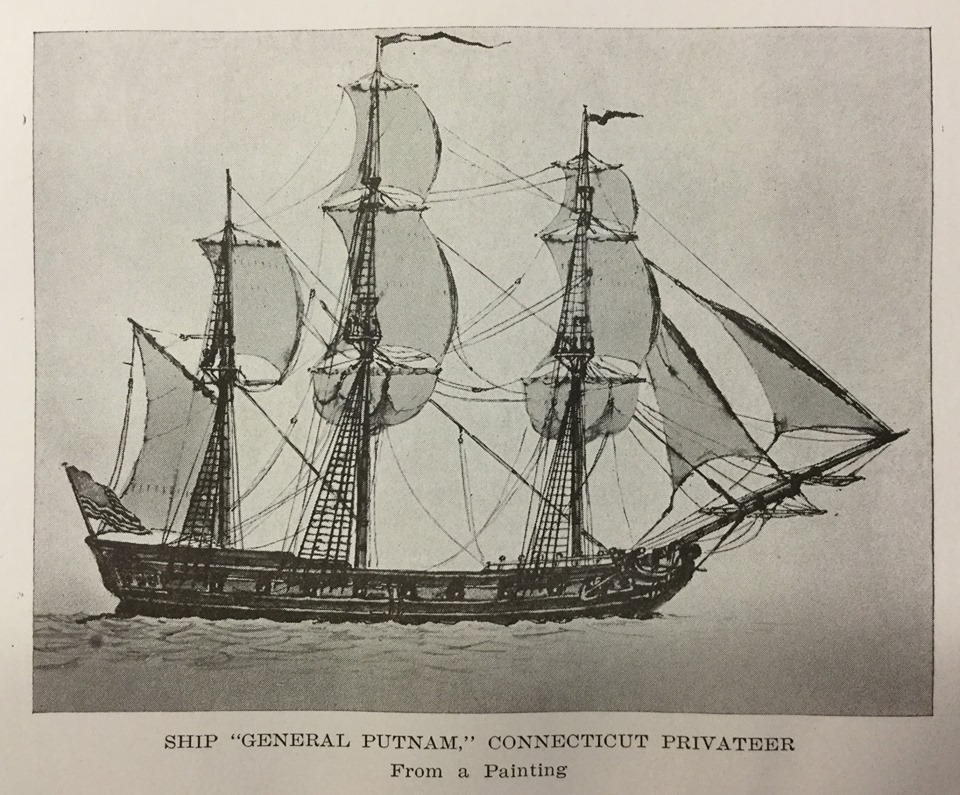 On August 13th,1779, Captain Daniel Waters and his crew abandoned the ship General Putnam along the Penobscot River and then set her ablaze. Once ashore, they began the long journey over land back to Boston. Putnam was part of a 44 ship flotilla tasked with driving the British from the Penobscot Peninsula in what is present day Maine. In a disastrous defeat, the American fleet was forced to flee four British frigates. One by one the American ships were either captured, destroyed, or abandoned and burned. Waters, a native of Charlestown, Massachusetts, was a seasoned military officer. Waters began service for his country as a Minuteman. One of the many who was roused by Paul Revere Lexington and Concord.
On August 13th,1779, Captain Daniel Waters and his crew abandoned the ship General Putnam along the Penobscot River and then set her ablaze. Once ashore, they began the long journey over land back to Boston. Putnam was part of a 44 ship flotilla tasked with driving the British from the Penobscot Peninsula in what is present day Maine. In a disastrous defeat, the American fleet was forced to flee four British frigates. One by one the American ships were either captured, destroyed, or abandoned and burned. Waters, a native of Charlestown, Massachusetts, was a seasoned military officer. Waters began service for his country as a Minuteman. One of the many who was roused by Paul Revere Lexington and Concord.
During the siege of Boston he commanded a small gunboat, and then was appointed the captain of the schooner Lee by George Washington in 1776. The General assisted Waters again a year later when he appointed the Charlestown man a captain the the Continental Navy. In the following years Waters captained the frigate Fox and the sloop General Gates. In 1779 Waters was given the Putnam after the ship had been pressed into service by the Sherifff of Suffolk County Massachusetts.
Dudley Saltonstall was the commodore of the fleet for the Penobscot expedition. In addition to the flotilla was a force of 1,200 men both marines and militia an, and 100 artillerymen under the command of Lt. Col. Paul Revere. Such was the failure of the expedition, but Saltonstall and Revere were tried before a court martial. Saltonstall was tried for ineptitude and declared incompetent. Paul Revere faced a number of charges, but was only asked to resign his command. His reputation smeared, Revere continued to ask for a full Court martial to clear his name. That finally occurred in September of 1783. The court convened and cleared the patriot’s name.
The lack of action was felt keenly by the all the forces during the expedition. Many of the officers complained to Saltonstall about his caution in moving the fleet. Even men aboard the ships chafed at the caution. A letter from the Putnam was sent to Saltonstall asking him to engage the enemy in polite and flowery terms. However of the 150 crew, the letter was only signed by the First Lieutenant and thirty others. Nor did Waters’ signature appear. The offensive dragged on until the reinforcements the British were waiting for arrived. August 12th 1779, found Waters fleeing from the British. Unable to escape after a day of sailing, the captain chose to abandon his ship and, burn the General Putnam to keep her from the enemy.
Two years prior to the disaster at Penobscot, Nathaniel Shaw Jr., began construction of a new ship at Windthrop’s neck in New London. She was a good sized vessel meant to carry a crew of 150. Shaw outfitted his newest privateer with 20 cannon, 9 pounders purchased in Norwich Connecticut. When she finally rolled down her stays, the General Putnam cost 50 thousand pounds to build. In 2020 that is approximately 8.25 million dollars. She was commissioned on April 23 1778, and got underway for her first voyage in May of the same year.
Thomas Allen of New London, a partner in the $10,000 bond for Putnam, was made captain for her maiden voyage. Shaw provided Allen with the following orders.
“NATHANIEL SHAW, Jr., & CO. TO CAPTAIN THOMAS Allen
Sir New London [Conn.] May 24. 1778 You are now Commander of the Privat[eer] Ship of Warr General Putnam, fitted & Man’d for a Cruize of Six Months against the Enimies of the United States, & now lying at Anchor in this Port, and our Orders to you are, That you Sail on a Cruize the first fair wind (after your Men are on board) a
nd Cruize where you think it will best Answere the desirable purpose viz. to take as many British Merchantmen Ships as you can Man, and send into the most convenient Port of the United States in America, should prefer New London, but if they fall into Bedford1 let the Prize Master apply to Joseph Russell Junr., if to the Eastward of that Port to Col Josiah Waters at Boston If to the Westward, Newbern to John W. Stanley,2 to the Westward of that to such Gen- tlemen as you think are Men of Honesty & Interest & that you can recomend as Such, & desire them to write me immediately, & dispose of Vessels & Cargo & let me know to what Amo. the prizes may have sold for, that we may draw on them for that sum We
wish you a Good Cruize and Safe Return to your Friends & OwnersNathel. Shaw Junr & Co.
A True Copy of the Original Thos. Allen”
It made sense that Shaw sent Allen to Boston, because the Captain had lived in the city prior to marrying a woman from New London. Allen cruised for 5 months and captured a total of 6 english brigs before returning to New London. Allen did not return to sea, but went back to managing his public house in the city.
Putnam sailed out of New London Harbor again in May of 1779 under the command of Nathaniel Saltonstall, brother of Dudley Saltonstall. Once again the privateer sailed the waters off the coast of Massachusetts. This time, however, Shaw gave orders that all captures were to be sent to New London and not to the port of Boston. Putnam captured three ships before encountering foul weather on the 26th of June, forcing her to anchor in Boston Harbor. Unfortunately on the 16th of June the British had landed a force to settle an area in Massachusetts on the Penobscot River. In addition to being a new settlement, New Ireland was to be haven for loyalists fleeing the colonies. In response to this incursion, The Massachusetts General Assembly appointed a Council of War to mount an expedition to drive the British from the Penobscot Peninsula. On July 2nd, 1779 the Council ordered the Sheriff of Suffolk County to press the ship Putnam into service.
Nathiel Shaw Jr. did not see any compensation for the seizure and destruction of the ship he had built. After arriving in Boston, Nathaniel Saltonstall was asked to give the ship over to the expedition. He declined feeling he did not have the right without the consent of the owners. The matter was decided by the Massachusetts Assembly. After the legislature authorized the pressing of the ship, Saltonstall was asked to assess her value. Again he declined. The Assembly appointed three captains to assess the ship. They determined her value value to be £10,000 sterling, with an estimate of future value at £100,000 paper money. It took until 1783 for the General Court to settle the matter. A year after Nathaniel Shaw Jr. died, the state of Massachusetts paid the Shaw company the sum of £10,133. 6s. 8d. in compensation for the loss of the privateer ship General Putnam.
